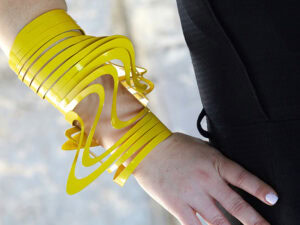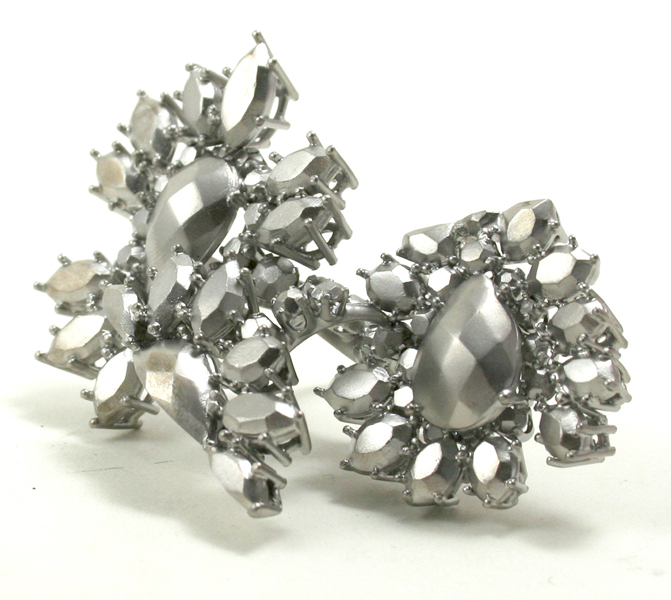
Susan Cummins: Can you give us a snapshot description of your background. Were you trained as a jeweler?
Anya Kivarkis: I received an undergraduate degree in craft with a focus on jewelry and metalsmithing from the University of Illinois at Urbana-Champaign. I continued with graduate school in the metal program at SUNY, New Paltz. It was really the combination of programs that enabled me to be a strong maker of both hollowware and jewelry and to think critically about my practice. They left me interested in the possibilities of working within the conditions of the discipline of jewelry and metalsmithing and in mining the history, objects, and subjects embedded in the field as content. I also worked for several years as a jeweler in Chicago between undergraduate and graduate school.
What kinds of questions do you ask yourself in the process of making things?
Anya Kivarkis: I think one of the strongest questions is, “What am I making?” I recreate jewelry objects from a range of source images. There always comes a point in the production of my work when it hedges too close to what it is simulating, and it gets uncomfortable. The work begins to make sense when the physical reproductions I make are mediated by the reality of the images I am sourcing, because it mutates the object and makes it a representation of a representation, distancing it from the original, ideal object.

Can you describe the ideas that are embedded in the pieces presented in this show called September Issue?
Anya Kivarkis: This body of work is a series of jewelry reconstructed from a spread in the Vogue, September 2007 issue titled “Paris Je T’aime.” At the time, it was Vogue magazine’s largest (most pages), and most infamous issue in its history and was released at the beginning of the global financial crisis of 2007–08. Through the trajectory of my work, I have appropriated material culture from historical moments of imperialism, including the Baroque, the Victorian, and our contemporary period, because they are speculated to be moments in which aesthetic cultures of excess and luxury resurge within fashion. The history of material culture suggests that imperialist expansion or control has often been coupled with economic recession, and that in these times we surround ourselves with luxury goods that reflect wealth or images of progress … to conceal our underlying economic decline. I am interested in moments in history that generate massive amounts of desire that are coupled with a strong economic recession and a collective inability to fulfill that desire. So, I chose to focus on the amplified and excessive jewelry in this spread.
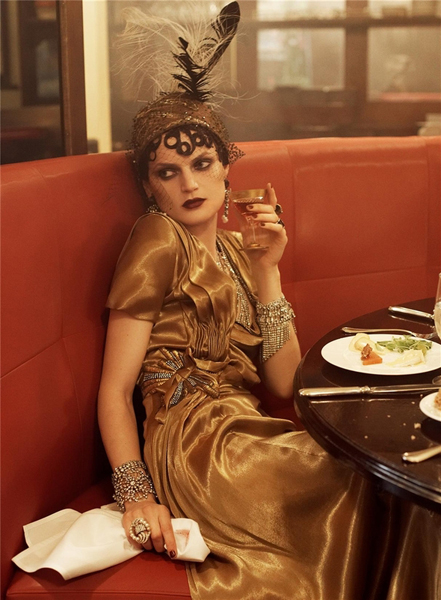
Another dimension of this project that interests me is that the “Paris Je T’aime” spread is situated in the “Roaring 1920s”—the period of sustained economic prosperity and accelerated consumption that was ended by the 1929 Wall Street crash and the onset of the Great Depression.
Historically in my work, I consider both how desire exists and is constructed around material culture and examine ways to revise decorative historical objects. From this “Paris Je T’aime” spread, I am reconstructing several pieces of jewelry found in these images. I am replicating only what is observable in the image of the jewelry mediated through the image, building the obstruction and gesture of the wearer’s body, blurriness, accumulations of glare, and perspective and sideways views into the remade objects themselves.
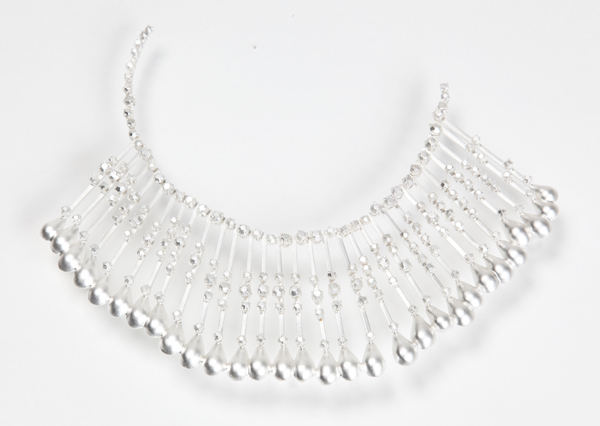
Anya Kivarkis: My intentions in revising these objects are partially subversive and partially out of fascination, discerning, and curiosity. I should add that the work is challenging the culture of luxury and also questioning the culture of the image. My work reflects my love/loathe relationship with both. An interrogation of representations of jewelry is central to my creative practice. It interests me that distant and recent history has been supplanted by representations, and how these representations have become history surrogates for the original objects. Because historical originals have vanished, and historical or contemporary objects might be inaccessible to us, I am curious about looking at the remaining traces of these objects and considering what might be lost or renegotiated in our knowledge of things, as they are increasingly understood through reproduction and the image. I think Laura Linney, Red Carpet 2008 can be a good example of this.
You have sourced a lot of historical periods of jewelry as well as numerous paintings, photographs, and drawings for all of your work. Your approach is very intellectual. Do you think you are able to convey these ideas in the pieces themselves without explanations attached? Or does that matter?
Anya Kivarkis: In my work, I source historical sketches by jewelry designers of the Baroque era, representations of jewelry in Baroque portrait paintings, photographs of Victorian jewelry, images from video and film stills, contemporary paparazzi photographs of celebrities wearing jewelry, and contemporary fashion photography.

For my first solo exhibition with Sienna Gallery in 2007 titled Blind Spot, my work assumed an archival dimension. I began by looking at highly ornamental sketches from the Baroque era by Marcus Gunther and translating the sketches into objects. In Marcus Gunter Sketch, c. 1711, when deciphering parts of the representations where the details are too small or unclear in the reproduction, I interrupted the form with a placeholder, a blank spot, or a shallow cube that obscured the implied contents beneath. In the same exhibition, I began making copies of representations in Baroque portrait paintings. In this work, I appropriated the neckpieces worn by the figures in the images, and I lifted the representations directly from their painted origins. I recreated these pieces as they were truncated, as fragments that were seemingly in perspective, a direct translation of my incomplete view through their representation. When worn, the way these neckpiece fragments are visually understood is open and contingent on the wearer’s movement through space. There are moments when the wearer turns in space, and the piece perceptually appears right. As the wearer rotates frontally, the wrongness of the object reveals itself, because the wearer and the object exist within different visual points of view.
For my next solo exhibition with Galerie Rob Koudijs, Vanishing Point, I began recreating jewelry objects from paparazzi images of celebrities wearing jewelry on the red carpet at the Academy Awards. These were interesting to me as a different type of portrait than a historical Dutch Baroque portrait. I was curious about the aura of the celebrity, and how these objects might achieve an arbitrary significance through their connections to famous figures. These images were sourced from the Internet, a democratic and accessible archive of information. I selected the Internet because of its nature as a mega-archive that disseminates information in a way that causes a fractured sense of time and place and fragmented sense of knowing. It is an ever-changing, unstable, and arbitrary archive that trivializes history and meaning and confirms our fragile presence in time and space. In the space of this kind of media, we are in so many real and virtual places simultaneously that we are prevented from being absorbed in any of them. I am interested in examining the disconnect from our presence in time and space that this image-based source causes. My interest in craft is directly related, and my work poses questions about how we currently understand the world through a stream of media images that increasingly sever or complicate our connections to haptic experience.
I want to render this space that can be dehumanizing in more humane ways, with resulting objects that are more tactile than the images that represent them. In reproducing objects from Internet images, I considered what I could understand as a spectator through the conditions of the media format through which I am viewing. I applied the visual logic of the Internet’s sequential, fleeting, fragmentary, snapshot image to the objects that I reproduced. In appropriating and recreating the jewelry worn by celebrities at the Academy Awards, the jewelry is made with its visual obstructions left intact. I replicate only what is observable in the image of the jewelry mediated through the screen, building the obstruction and gesture of the wearer’s body, the cropping of the frame, blurriness, accumulations of glare, and perspectival and sequential views into the object.
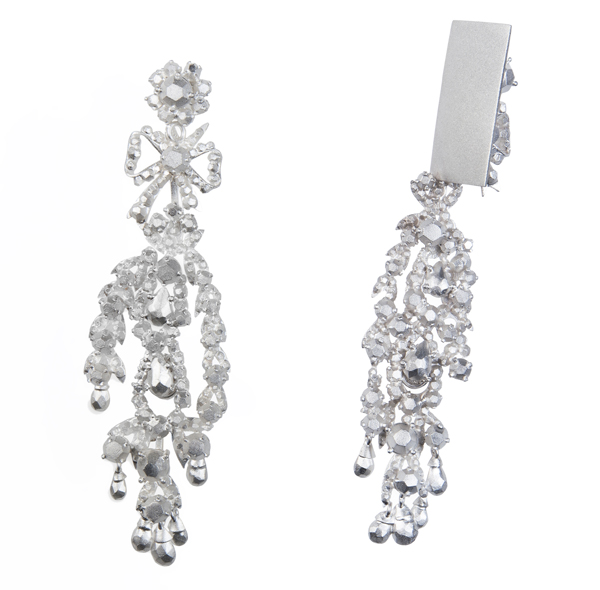
I think the crux of the work is what gets lost in translation from an object represented in an image to a translation of the image back into an object, and how it speculates about what gets lost through representation in an image-based culture. When you see the objects, they are clearly not whole, but fragments of an unknown whole. They are speculative, and I think they raise questions for the viewer. That is really my intent, to raise questions rather than to present answers. With that said, there are multiple ways to experience or receive the work—as critically motivated objects, on a purely visual level, or somewhere in between.
You have been a professor at the University or Oregon for a number of years. What do you love about teaching? What is a drag?
Anya Kivarkis: I just recently received tenure and have been on sabbatical for these past two terms. What I have missed about teaching is how I need to research to support a broad range of ideas and anticipate possibilities for my students’ practices. As you can imagine, that responsibility keeps me informed in an expansive way. I absolutely love teaching a course called “Issues & Practices” at the graduate and fifth-year BFA level. I love developing reading lists that are the synthesis of ideas from a range of disparate disciplinary inquiries that frame current, critical potentials for the field. The group conversations I have had with students in that context have honestly been enlightening and transformative. I tell my students all of the time that they blow my mind. I think this happens especially when people allow themselves to be vulnerable and open to failure. The conversations get most interesting when we talk really extensively about ideas in the readings through potentials for each student’s work. My students have been so generous and willing to speculate about potentials for one another’s work and so interested in this collective inquiry that it makes all of the “drags” worthwhile.
What is challenging about teaching is how consuming it can be and the need to protect studio time for my own research. I wouldn’t mind fewer interruptions. Sabbatical has reminded me of that. It has really been a gift.
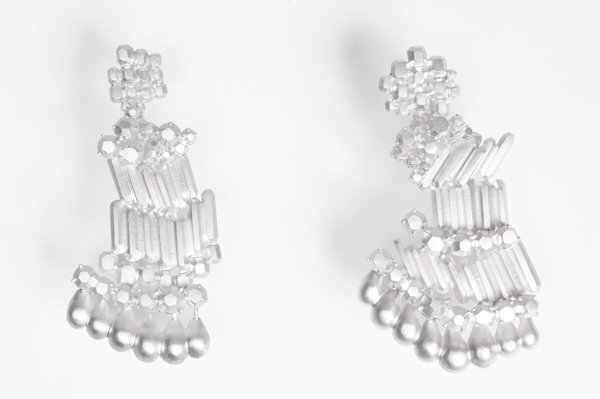
Anya Kivarkis: I am interested in the realities of how interdisciplinarity affects the field of jewelry and metalsmithing within academia. The University of Oregon has quite a strong interdisciplinary program at both the undergraduate and graduate levels, so practices that engage what is central to the field are responsible for engaging peers and faculty in a really rigorous way … meaning that students can’t retreat into the comfortable conversation within the field and assume that the audience is familiar. It is a challenge and an opportunity for students to know historical and contemporary issues and trajectories in the field and understand how to locate their own practices within the expanded field. Whether they are working at the center or the periphery of the field, I am interested in how work that retains the specificity of the field’s discourse can generate new knowledge.
For me, the reality of this is that it boils down to research. It excites me to see new, documented research in the field, and I love to watch students synthesize disparate research sources into new and idiosyncratic ways of thinking and working through ideas. To help them do this, my students are always working on an evolving annotated bibliography to concretize their research and relate it back to their practices.
What have you seen, read, or heard lately that has excited you?
Anya Kivarkis: There are a few things that link to various parts of my practice that have recently interested me. I traveled to Amsterdam for this show with Galerie Rob Koudijs, and while there visited the Rijksmuseum and saw a wide range of Dutch Baroque portraits and still life paintings. It was really amazing to see these paintings in real space because of their hyper-real optic qualities that are actually constructed through their haptic physicality. This connects to prior work and a formative essay for me by Martin Jay titled “Scopic Regimes of Modernity” from a series of lectures compiled by Hal Foster in Vision and Visuality.
I also started re-reading Glenn Adamson’s The Invention of Craft and became interested in the relationship between the Depression era and world fairs. This reminded me of how I started thinking about the pre-Depression, hubristic roaring 20s spread as the subject of my exhibition.
While I was in Milwaukee, Ethan Lasser, former curator of the Chipstone Foundation did a tour of the Chipstone collection and described the historical and lived contexts of the objects in the collection. He talked of the dim candlelight characteristic of domestic interiors in the Baroque and Victorian eras, and how the scale of metal fixtures (drawer pulls for example) and ornament were disproportionately large to reflect this light in a magnified way that glorified these objects. This piqued my curiosity about historical displays of domestic luxury and triggered ideas and research for future exhibitions.
A few other books that I am reading and thinking about cinematic time, perception, and glamour are Daniel Birnbaum’s, Chronology, Dan Graham’s Two-Way Mirror Power, Kate Mondloch’s Screens, and Virgina Postrel’s The Power of Glamour. These are linked to some ideas I am considering for an upcoming collaborative exhibition with Mike Bray at Sienna Patti Contemporary.
Thanks, Susan. This has been a pleasure.



